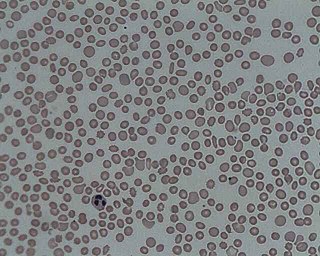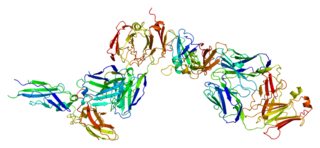
An anticoagulant, commonly known as a blood thinner, is a chemical substance that prevents or reduces the coagulation of blood, prolonging the clotting time. Some occur naturally in blood-eating animals, such as leeches and mosquitoes, which help keep the bite area unclotted long enough for the animal to obtain blood.

Platelets or thrombocytes are a blood component whose function is to react to bleeding from blood vessel injury by clumping, thereby initiating a blood clot. Platelets have no cell nucleus; they are fragments of cytoplasm derived from the megakaryocytes of the bone marrow or lung, which then enter the circulation. Platelets are found only in mammals, whereas in other vertebrates, thrombocytes circulate as intact mononuclear cells.

Coagulation, also known as clotting, is the process by which blood changes from a liquid to a gel, forming a blood clot. It results in hemostasis, the cessation of blood loss from a damaged vessel, followed by repair. The process of coagulation involves activation, adhesion and aggregation of platelets, as well as deposition and maturation of fibrin.

Fibrinogen is a glycoprotein complex, produced in the liver, that circulates in the blood of all vertebrates. During tissue and vascular injury, it is converted enzymatically by thrombin to fibrin and then to a fibrin-based blood clot. Fibrin clots function primarily to occlude blood vessels to stop bleeding. Fibrin also binds and reduces the activity of thrombin. This activity, sometimes referred to as antithrombin I, limits clotting. Fibrin also mediates blood platelet and endothelial cell spreading, tissue fibroblast proliferation, capillary tube formation, and angiogenesis and thereby promotes revascularization and wound healing.
In biology, hemostasis or haemostasis is a process to prevent and stop bleeding, meaning to keep blood within a damaged blood vessel. It is the first stage of wound healing. Hemostasis involves three major steps:

In hematology, thrombocytopenia is a condition characterized by abnormally low levels of platelets in the blood. Low levels of platelets in turn may lead to prolonged or excessive bleeding. It is the most common coagulation disorder among intensive care patients and is seen in a fifth of medical patients and a third of surgical patients.

Deep vein thrombosis (DVT) is a type of venous thrombosis involving the formation of a blood clot in a deep vein, most commonly in the legs or pelvis. A minority of DVTs occur in the arms. Symptoms can include pain, swelling, redness, and enlarged veins in the affected area, but some DVTs have no symptoms.

Tissue factor, also called platelet tissue factor or Coagulation factor III, is a protein present in subendothelial tissue and leukocytes which plays a major role in coagulation and, in humans, is encoded by F3 gene. Its role in the blood clotting is the initiation of thrombin formation from the zymogen prothrombin. Thromboplastin defines the cascade that leads to the activation of factor X—the tissue factor pathway. In doing so, it has replaced the previously named extrinsic pathway in order to eliminate ambiguity.

Compression stockings are a specialized hosiery designed to help prevent the occurrence of, and guard against further progression of, venous disorders such as edema, phlebitis and thrombosis. Compression stockings are elastic compression garments worn around the leg, compressing the limb. This reduces the diameter of distended veins and increases venous blood flow velocity and valve effectiveness. Compression therapy helps decrease venous pressure, prevents venous stasis and impairments of venous walls, and relieves heavy and aching legs.
Purpura fulminans is an acute, often fatal, thrombotic disorder which manifests as blood spots, bruising and discolouration of the skin resulting from coagulation in small blood vessels within the skin and rapidly leads to skin necrosis and disseminated intravascular coagulation.
The dysfibrinogenemias consist of three types of fibrinogen disorders in which a critical blood clotting factor, fibrinogen, circulates at normal levels but is dysfunctional. Congenital dysfibrinogenemia is an inherited disorder in which one of the parental genes produces an abnormal fibrinogen. This fibrinogen interferes with normal blood clotting and/or lysis of blood clots. The condition therefore may cause pathological bleeding and/or thrombosis. Acquired dysfibrinogenemia is a non-hereditary disorder in which fibrinogen is dysfunctional due to the presence of liver disease, autoimmune disease, a plasma cell dyscrasias, or certain cancers. It is associated primarily with pathological bleeding. Hereditary fibrinogen Aα-Chain amyloidosis is a sub-category of congenital dysfibrinogenemia in which the dysfunctional fibrinogen does not cause bleeding or thrombosis but rather gradually accumulates in, and disrupts the function of, the kidney.
Sticky platelet syndrome (SPS) is a heritable disorder of platelet function in which platelet hyperaggregation leads to hypercoagulability. It was first described by Mammen in 1983. It is inherited in an autosomal dominant pattern. It has not been associated with a specific gene, and it is not recognized as an entity in OMIM.

Betrixaban is an oral anticoagulant drug which acts as a direct factor Xa inhibitor. Betrixaban is FDA approved for venous thrombosis prevention in adults hospitalized for an acute illness who are at risk for thromboembolic complications. Compared to other directly acting oral anticoagulants betrixaban has relatively low renal excretion and is not metabolized by CYP3A4.

Clinical and Applied Thrombosis/Hemostasis is a peer-reviewed medical journal covering research in the field of hematology. The editor-in-chief is Charles A. Carter. It was established in 1995 and is published by SAGE Publications.
The International Society on Thrombosis and Haemostasis (ISTH) is a not-for-profit global membership organization of specialists in the field of blood coagulation and its disorders, such as thrombosis and hemophilia. It was founded in 1954 as the International Committee on Thrombosis and Haemostasis (ICTH). The society was reorganized in 1969 as the ISTH. It currently represents about 5,000 members from 98 different countries. The society initiates and promotes education and outreach initiatives, research activities, scientific meetings, peer-reviewed publications, expert committees and the development of standards allowing a common language and approach to basic and clinical science all over the world. It also publishes the medical journal Journal of Thrombosis and Haemostasis and its open access counterpart, Research and Practice in Thrombosis and Haemostasis.
Blood clotting tests are the tests used for diagnostics of the hemostasis system. Coagulometer is the medical laboratory analyzer used for testing of the hemostasis system. Modern coagulometers realize different methods of activation and observation of development of blood clots in blood or in blood plasma.
Expert Review of Hematology is a MEDLINE-indexed, peer-reviewed, international medical journal publishing review articles and original papers on all aspects of hematology. It is part of the Expert Review series, published by Informa.
Thrombosis Research is an international peer-reviewed medical journal published by Elsevier with a goal of rapid dissemination of new information on thrombosis, hemostasis, and vascular biology to advance science and clinical care. The journal publishes peer-reviewed original research, along with reviews, editorials, and opinions and critics. Both basic and clinical studies are published. Publication of research which will lead to novel approaches in diagnosis, therapy, prognosis and prevention of thrombotic and hemorrhagic diseases is given high priority.

Thrombosis and Haemostasis is a peer-review scientific journal of medicine. It is published by Thieme Medical Publishers. It is the official journal of several groups and societies: European Society of Cardiology, Sociedad Española de Trombosis y Hemostasia, Australian Vascular Biology Society, and Gesellschaft für Thrombose- und Hämostaseforschung e.V. A related publication is TH Open. The journal was established in 1957 and is published monthly. The current editors-in-chief are Christian Weber and Gregory Y. H. Lip.

Marie Claire McLintock was a New Zealand haematologist and obstetric physician. She was an expert in medical conditions and disorders related to bleeding and blood clotting, and medical problems associated with pregnancy.











